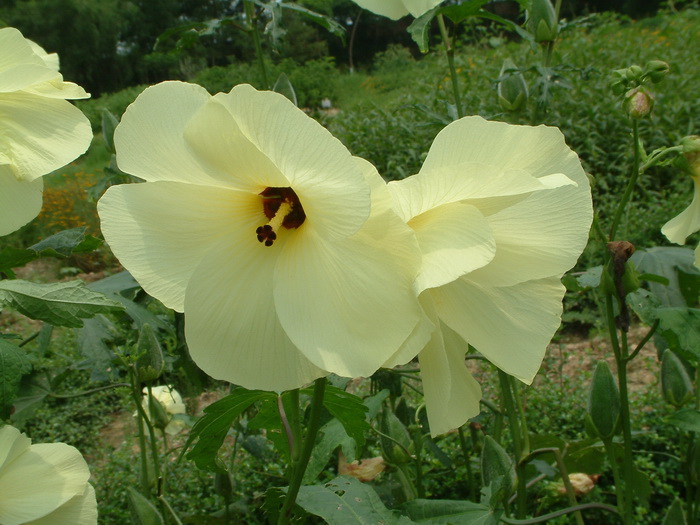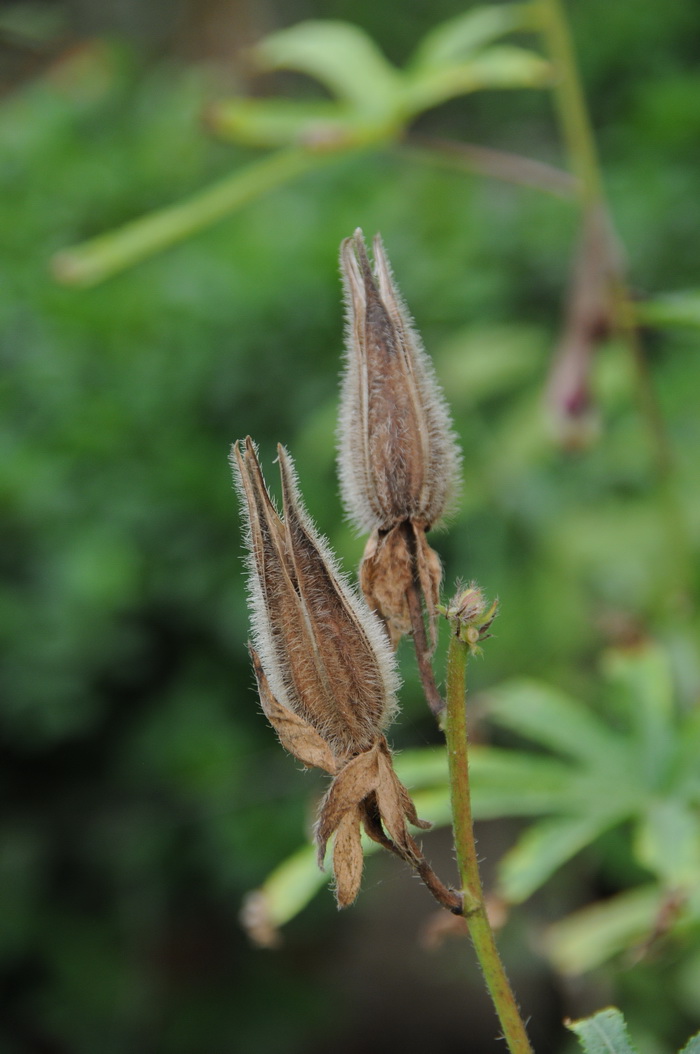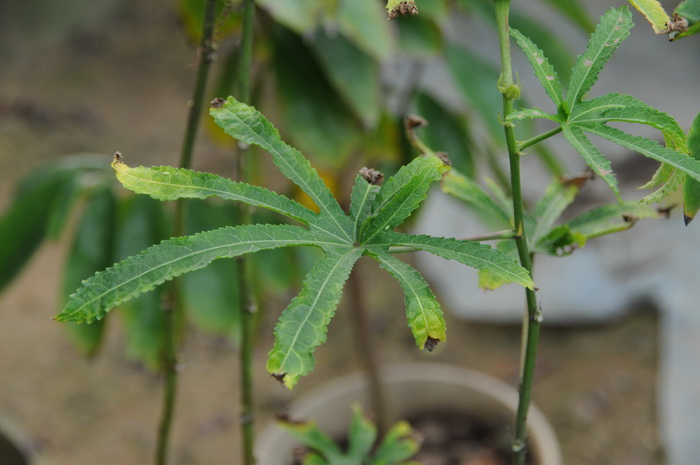黄蜀葵Abelmoschus manihot
中文名(Chinese Name):黄蜀葵
学名(Scientific Name):Abelmoschus manihot (L.) Medik.
英文名(English Common Name):
别名(Chinese Common Name):秋葵、棉花葵
异名(Synonym):Hibiscus japonicus Miq. Hibiscus manihot L. Hibiscus manihot var. palmatus DC. Hibiscus manihot var. typicus Hochr. Abelmoschus caillei (A.Chev.) Stevels Abelmoschus manihot f. platidactylis Bakh. Abelmoschus manihot var. dissecta Abelmoschus manihot var. megaspermus Hemadri Abelmoschus manihot var. timorensis (DC.) Hochr. Abelmoschus platidactylus (Bakh.) Nakai Abelmoschus pseudomanihot (DC.) Endl. Hibiscus papyriferus Salisb.
科属(Family & Genus):锦葵科(Malvaceae)秋葵属
形态特征(Description):一年生或多年生草本,高1-2米,疏被长硬毛。叶掌状5-9深裂,直径15-30厘米,裂片长圆状披针形,长8-18厘米,宽1-6厘米,具粗钝锯齿,两面疏被长硬毛;叶柄长6-18厘米,疏被长硬毛;托叶披针形,长11-1.5厘米。花单生于枝端叶腋;小苞片4-5,卵状披针形,长15-25毫米,宽4-5毫米,疏被长硬毛;萼佛焰苞状,5裂,近全缘,较长于小苞片,被柔毛,果时脱落;花大,淡黄色,内面基部紫色,直径约12厘米;雄蕊柱长1.5-2厘米,花药近无柄;柱头紫黑色,匙状盘形。蒴果卵状椭圆形,长4-5厘米,直径2.5-3厘米,被硬毛;种子多数,肾形,被柔毛组成的条纹多条。花期8-10月。
分布(Distribution):产河北、山东、河南、陕西、湖北、湖南、四川、贵州、云南、广西、广东和福建等省区。生于山谷草丛、田边或沟旁灌丛间。印度也有。
用途(Use):本种的花大色美,栽培供园林观赏用;根含粘质,可作造纸糊料;种子、根和花作药用。
引自中国植物志英文版:FOC Vol. 12 Page 283, 284
Abelmoschus manihot (Linnaeus) Medikus, Malvenfam. 46. 1787.
黄蜀葵 huang shu kui | Malvaceae | Abelmoschus
Herbs annual or perennial, 1-2 m tall, most parts long simple-hispid and minutely simple- or few-rayed pubescent. Stipules linear-lanceolate, sometimes 2 on each side of petiole, 1-1.5 cm; petiole 6-18 cm; leaf blade palmately 5-9-lobed, 15-30 cm in diam., lobes oblong-lanceolate, sometimes ± pinnately lobed, 8-18 × 1-6 cm, sparsely long hispid on both surfaces, margin robustly, obtusely serrate. Flowers solitary, subapical and forming terminal raceme; pedicel 1.5-4 cm. Epicalyx lobes 4 or 5, ovate-lanceolate, 15-25 × 4-5 mm, sparsely long hispid. Calyx spathaceous, minutely 5-lobed, nearly entire, longer than epicalyx, puberulent only, not hispid, caducous at fruiting. Corolla yellow with purple center, ca. 12 cm in diam. Staminal column 1.5-2.5 cm; anthers nearly sessile. Stigma purple-black, spatulate-disk-shaped. Capsule ovoid-ellipsoid, 4-5 × 2.5-3 cm, densely hirsute. Seeds many, reniform, with several lines of hairs. Fl. Aug-Oct.
Grasslands, streamsides, margins of farms; 1000-2100 m. Fujian, Guangdong, Guangxi, Guizhou, Hebei, Henan, Hubei, Hunan, Shaanxi, Shandong, Sichuan, Taiwan, Yunnan [India, Nepal, Philippines, N Thailand].
Borssum Waalkes (Blumea 14: 96-100. 1966) recognized two SubSpe: subsp. manihot and subsp. tetraphyllus (Roxburgh) Borssum Waalkes. The latter further divided into var. pungens, with prickly hairs on the epicalyx, and var. tetraphyllus, which is found in Indonesia and Philippines, without such hairs on the epicalyx.


 (责任编辑:徐晔春)
(责任编辑:徐晔春)
学名(Scientific Name):Abelmoschus manihot (L.) Medik.
英文名(English Common Name):
别名(Chinese Common Name):秋葵、棉花葵
异名(Synonym):Hibiscus japonicus Miq. Hibiscus manihot L. Hibiscus manihot var. palmatus DC. Hibiscus manihot var. typicus Hochr. Abelmoschus caillei (A.Chev.) Stevels Abelmoschus manihot f. platidactylis Bakh. Abelmoschus manihot var. dissecta Abelmoschus manihot var. megaspermus Hemadri Abelmoschus manihot var. timorensis (DC.) Hochr. Abelmoschus platidactylus (Bakh.) Nakai Abelmoschus pseudomanihot (DC.) Endl. Hibiscus papyriferus Salisb.
科属(Family & Genus):锦葵科(Malvaceae)秋葵属
形态特征(Description):一年生或多年生草本,高1-2米,疏被长硬毛。叶掌状5-9深裂,直径15-30厘米,裂片长圆状披针形,长8-18厘米,宽1-6厘米,具粗钝锯齿,两面疏被长硬毛;叶柄长6-18厘米,疏被长硬毛;托叶披针形,长11-1.5厘米。花单生于枝端叶腋;小苞片4-5,卵状披针形,长15-25毫米,宽4-5毫米,疏被长硬毛;萼佛焰苞状,5裂,近全缘,较长于小苞片,被柔毛,果时脱落;花大,淡黄色,内面基部紫色,直径约12厘米;雄蕊柱长1.5-2厘米,花药近无柄;柱头紫黑色,匙状盘形。蒴果卵状椭圆形,长4-5厘米,直径2.5-3厘米,被硬毛;种子多数,肾形,被柔毛组成的条纹多条。花期8-10月。
分布(Distribution):产河北、山东、河南、陕西、湖北、湖南、四川、贵州、云南、广西、广东和福建等省区。生于山谷草丛、田边或沟旁灌丛间。印度也有。
用途(Use):本种的花大色美,栽培供园林观赏用;根含粘质,可作造纸糊料;种子、根和花作药用。
引自中国植物志英文版:FOC Vol. 12 Page 283, 284
Abelmoschus manihot (Linnaeus) Medikus, Malvenfam. 46. 1787.
黄蜀葵 huang shu kui | Malvaceae | Abelmoschus
Herbs annual or perennial, 1-2 m tall, most parts long simple-hispid and minutely simple- or few-rayed pubescent. Stipules linear-lanceolate, sometimes 2 on each side of petiole, 1-1.5 cm; petiole 6-18 cm; leaf blade palmately 5-9-lobed, 15-30 cm in diam., lobes oblong-lanceolate, sometimes ± pinnately lobed, 8-18 × 1-6 cm, sparsely long hispid on both surfaces, margin robustly, obtusely serrate. Flowers solitary, subapical and forming terminal raceme; pedicel 1.5-4 cm. Epicalyx lobes 4 or 5, ovate-lanceolate, 15-25 × 4-5 mm, sparsely long hispid. Calyx spathaceous, minutely 5-lobed, nearly entire, longer than epicalyx, puberulent only, not hispid, caducous at fruiting. Corolla yellow with purple center, ca. 12 cm in diam. Staminal column 1.5-2.5 cm; anthers nearly sessile. Stigma purple-black, spatulate-disk-shaped. Capsule ovoid-ellipsoid, 4-5 × 2.5-3 cm, densely hirsute. Seeds many, reniform, with several lines of hairs. Fl. Aug-Oct.
Grasslands, streamsides, margins of farms; 1000-2100 m. Fujian, Guangdong, Guangxi, Guizhou, Hebei, Henan, Hubei, Hunan, Shaanxi, Shandong, Sichuan, Taiwan, Yunnan [India, Nepal, Philippines, N Thailand].
Borssum Waalkes (Blumea 14: 96-100. 1966) recognized two SubSpe: subsp. manihot and subsp. tetraphyllus (Roxburgh) Borssum Waalkes. The latter further divided into var. pungens, with prickly hairs on the epicalyx, and var. tetraphyllus, which is found in Indonesia and Philippines, without such hairs on the epicalyx.
踩一下[0]

顶一下[11]